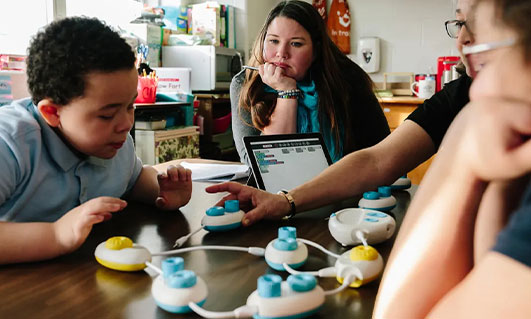
Technology has significantly transformed the way we learn, and this change has been especially impactful for visually impaired students. Among the various assistive devices available, Braille notetakers stand out as invaluable tools that enable visually impaired students to access information, take notes, and participate actively in classroom activities. Let’s explore the role of Braille notetakers in enhancing learning experiences and how they are paving the way for a more inclusive educational environment.
What are Braille Notetakers?
Braille notetakers are portable devices that allow visually impaired users to read and write in Braille. They combine a Braille keyboard with various digital functions, such as word processing, internet browsing, and email access. Braille notetakers often include refreshable Braille displays, which provide real-time tactile feedback, enabling users to read text as they type.
These devices are specifically designed to meet the needs of visually impaired students, offering features that simplify tasks such as note-taking, organizing assignments, and even accessing textbooks and other educational resources.
Benefits of Braille Notetakers in the Classroom
Enhanced Accessibility to Learning Materials: Braille notetakers give visually impaired students direct access to digital learning materials, which can be downloaded and read in Braille. With features like audio playback and text-to-speech, students can choose their preferred method of information intake, making learning more personalized and effective.
Increased Independence: With a Braille notetaker, visually impaired students can work independently, without the need for constant assistance. The device enables them to take notes, complete assignments, and study without relying on others, fostering self-reliance and confidence.
Improved Organization and Time Management: Many Braille notetakers come with built-in calendars, planners, and other organizational tools, helping students keep track of assignments, schedules, and deadlines. This aids in developing essential time management skills that are crucial for academic success.
Seamless Integration with Mainstream Technology: Modern Braille notetakers are compatible with popular software applications, enabling visually impaired students to work alongside their sighted peers. These devices can connect to computers, tablets, and smartphones, allowing students to access the same resources as their classmates, thus promoting inclusivity in the classroom.
Facilitated Communication with Teachers and Peers: Braille notetakers often include email and messaging capabilities, which can be used to communicate with teachers and classmates. This facilitates collaboration on group projects and helps students stay engaged in classroom discussions, even in virtual or hybrid learning environments.
Challenges and Considerations
While Braille notetakers offer numerous benefits, there are a few challenges associated with their use:
High Costs: Braille notetakers can be expensive, making them inaccessible for some students and schools. However, many organizations and government programs provide financial assistance to help students acquire these devices.
Learning Curve: For students who are new to Braille or assistive technology, learning to use a Braille notetaker can be a bit challenging. Providing training and support is essential to help students maximize the device’s potential.
Future of Braille Notetakers in Education
As technology advances, Braille notetakers continue to evolve, becoming more affordable, versatile, and user-friendly. Innovations in voice recognition, artificial intelligence, and connectivity are likely to further enhance these devices, offering even greater support for visually impaired students.
Conclusion
Braille notetakers are powerful tools that play a pivotal role in supporting visually impaired students. By providing access to digital resources, fostering independence, and enabling effective communication, these devices are helping to create an inclusive learning environment where every student has the opportunity to succeed. With continued advancements in assistive technology, the future of Braille notetakers looks promising, and their impact on education will only continue to grow.





